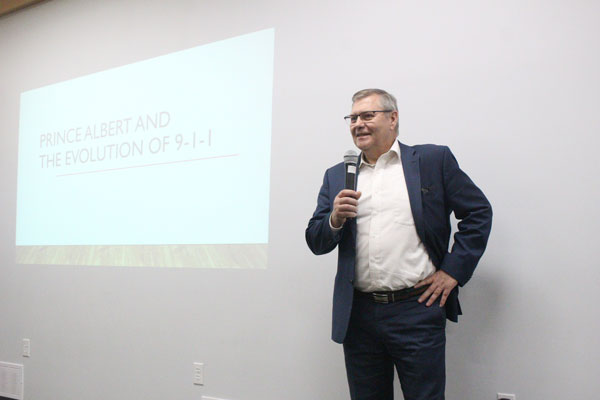
Many people do not know that Prince Albert played a key role in the development of the Provincial 9-1-1 system.
This was the topic of the Coffee and Conversation at the Prince Albert Historical Museum on Sunday. The speaker was Duane McKay, who is originally from Prince Albert and has been involved in the Public Safety sector for over 40 years.
McKay, who currently heads the Canadian Public Safety Operations Organization (CanOps), a not-for-profit organization focusing on developing innovative ideas in public safety, was part of the creation of the system.
“One of the things that we take for granted all across this province is 9-1-1 and we just expect it to be there,” McKay said. “That isn’t the case. If you go back into the mid ’90s the province wanted to implement that all across the province and Prince Albert played a major role.”
In his talk, McKay discussed how the concept of 9-1-1 came to be and how the province developed the system to what we know today.
Currently Prince Albert serves the entire province for 9-1-1 calls, except for Regina and Saskatoon. They report 50,000 calls total, with 30,000 coming though the Prince Albert Public Safety answering point.
“Up until about 2017 it was located in the basement of City Hall, and it’s now located in the Satellite Station, just a few miles west of the city,” McKay explained. “It is large, it’s comprehensive, it’s technologically advanced and it’s a bit of a hidden gem in the north part of Saskatchewan.”
In the late 1990s, the province looked at Swift Current, Saskatoon, Regina and Prince Albert sharing responsibilities for the system. Regina and Saskatoon were more interested in controlling their own services because of the scope and integration that was already in place.
“Swift Current and Prince Albert started working together. Swift Current eventually folded into Prince Albert and therefore established P.A. as the Rural 9-1-1 call centre for most of the of the province,” McKay said.
As the situation evolved around 2010 the old City Hall basement location became the hub for all rural 9-1-1 services and everything but Regina and Saskatoon.
“(It was) simply because of the innovation, the level of commitment, just the ability to service those smaller populations, as opposed to the larger centres,” McKay said.
McKay has had an interesting career to lead him to his current position. In 1981 he joined the Prince Albert Fire Department rising all the way to Battalion Chief in 1991. He served until 1996 when dispatch became centralized.
“The city wanted to consolidate police and fire dispatch at the time, and the people that were running that project were not interested in continuing on, so I thought, well, here’s an interesting thing,” McKay said. “I jumped on board with that in 1996 and ultimately stayed with it.”
Following his talk, which lasted over an hour, he quizzed those in attendance on facts that had been presented.
During his discussion, McKay said he volunteered because it was interesting to him and that continued throughout the development of the provincial 9-1-1 system.
“I left the city in 2001 and ran the provincial program then added Chief Emergency Planning Officer for the province, which is an EMO position, Fire Commissioner, head of the radio program and the 9-1-1 system as well,” he said.
His final position with the province was as Deputy Minister of Public Safety, which he left a few years ago.
“I’ve been involved 9-1-1 (and) it has been one of those mainstays from 1996 to today and we’re still running that,” he said.
McKay still runs the provincial 9-1-1 service through CanOps, which he founded in 2014. He said it started because he sat on a number of national committees and important items were not happening and that showed the need for a third party. CanOps took over the 9-1-1 operation in late 2017 and continue to run it.
Because the provincial 9-1-1 model is so successful it is seen as a benchmark in Canada so other jurisdictions want to use the concepts.
“It’s a government-owned service but it’s run by a not-for-profit,” he said. “We have legislation, we have a strong framework, we have funding put into place while I was there and all of the protocols, and obviously, a wide range of services provided across a very large province. Ultimately now we’re working with other provinces to see if we can replicate that in other jurisdictions.”
McKay explained that the invitation from the Historical Society gave the organization a chance to collect and create a history.
“I’m happy now that the museum has reached out to us,” he said. “We have not actually consolidated all of this information into one spot, so the museum now, by this request, this gathering a whole bunch of information on this tremendously amazing Saskatchewan success story, and so just really pleased to be here today.”
The December Coffee and Conversation will be the History of the Watsonairs on Sunday, Dec. 17 at 2 p.m.

